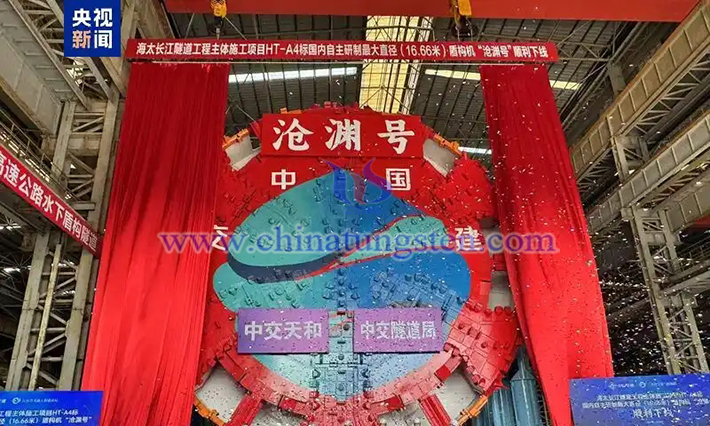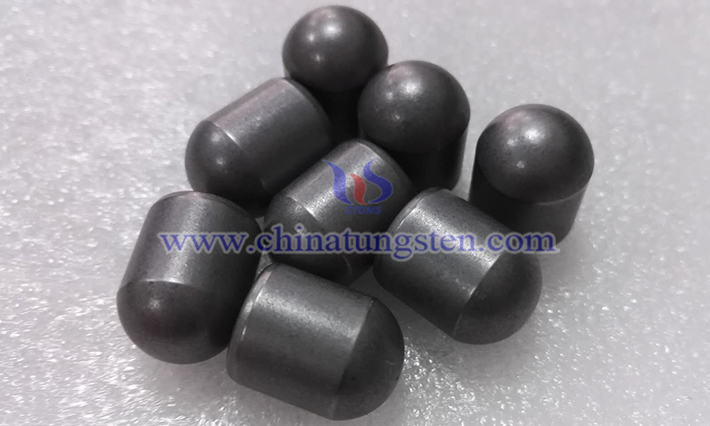Tungsten Enables the "Cang Yuan Hao" TBM to Roll Off the Production Line Successfully
- Details
- Category: Tungsten's News
- Published on Thursday, 03 April 2025 19:19
In the spring of Changshu, Jiangsu, a steel behemoth with a diameter of 16.07 meters—the "Cang Yuan Hao" tunnel boring machine (TBM)—slowly unveiled itself. This national treasure, entirely developed through independent research, is poised to inscribe a new legend along the banks of the Yangtze River. As eyes turn to this record-breaking engineering marvel, one must not overlook the "black gold" coursing through its veins—tungsten. This strategic metal interprets the warmth and resilience of Chinese manufacturing in a distinctive way.

Tungsten, element number 74 on the periodic table, has borne the DNA of industrial civilization since its discovery. In nature, it often exists as tough oxides, requiring intricate processes to refine into its metallic sheen. It is this quality of "remaining steadfast through countless trials" that renders tungsten an indispensable "steel tooth" in modern industry. On the cutterhead of "Cang Yuan Hao," hundreds of tungsten cemented carbide hob cutters, sharp as shark teeth, gnaw through the toughest granite at a steady pace of 2.5 revolutions per minute. These tungsten-based composite tools endure instantaneous temperatures up to 1200°C, enacting a modern industrial allegory of "grinding an iron rod into a needle" 40 meters beneath the Yangtze River bed.
The Haitai Yangtze River Tunnel project stands as a tempered sword, pushing Chinese engineering technology to its limits. This 11.36-kilometer-long "steel dragon" will wind its way through strata 90 meters underwater, navigating four complex geological zones. Tungsten materials exhibit remarkable adaptability here: in soft soil, the sharp edges of tungsten cemented carbide tools maintain precise cutting paths; in hard rock, their high-temperature stability prevents cracking. This blend of strength and flexibility mirrors the ingenuity of Chinese engineers—equipped with both the sharpness to pierce obstacles and the composure to master complexity.

From the tungsten mines of Dayu, Jiangxi, to the intelligent manufacturing hub in Changshu, the journey of tungsten reflects the evolution of Chinese industry. Inside the colossal frame of "Cang Yuan Hao," tungsten joins titanium alloys and high-strength steel to form a precise industrial neural network. As the machine advances 20 meters daily, sparks from the tungsten teeth clashing with rock strata testify not only to energy conversion but also to breakthroughs in material science. This progress shines through not just in the machine’s immense scale but in the bold exploration of material limits by Chinese engineers.
Gazing from the Yangtze’s banks, the extending tunnel stands as resilient as a tungsten filament, transforming natural barriers into pathways—an achievement that etches the dual legacy of material revolution and engineering innovation. When "Cang Yuan Hao’s" tungsten cutters slice through the first rock layer, what bursts forth is not merely debris but the radiant light of Chinese manufacturing breaking through barriers and ascending to new heights. This brilliance illuminates both the deep underwater tunnel and the grand journey of China’s high-end equipment toward self-reliance and strength.
- Chinatungsten Online: www.chinatungsten.com
- CTIA GROUP LTD: en.ctia.group
- Tungsten News & Price: www.ctia.com.cn
- Molybdenum News & Price: news.molybdenum.com.cn
- Tel.: 86 592 5129696; Email: sales@chinatungsten.com



 sales@chinatungsten.com
sales@chinatungsten.com